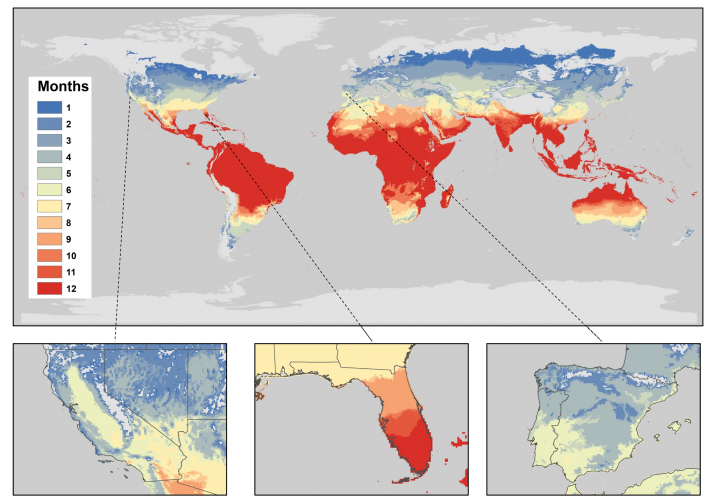New study shows where there may be establishment of citrus greening
University of Florida press release
New research, published in Journal of Applied Ecology maps the peak temperatures for the establishment of citrus greening disease.

Orange juice is a staple on many breakfast tables, but the future availability of citrus products is threatened by the global spread of Huanglongbing (HLB), also known as citrus greening disease. The bacterium responsible for causing citrus greening prevents the formation of commercially viable fruit and is transmitted by an insect called the Asian citrus psyllid. Both the pathogen and the insect vector have been spreading in recent years, devastating regions famous for high citrus production and threatening the future of the citrus industry. As citrus greening becomes an increasing threat to growers worldwide, the future of the industry may depend on identifying locations that do not have a high risk of production collapse.
Knowing which environmental conditions are suitable for disease transmission, and where those conditions occur, is vital for crop management both now and in the future. A new paper, published in Journal of Applied Ecology, ‘Predicting the fundamental thermal niche of crop pests and diseases in a changing world: a case study on citrus greening’, investigates the thermal suitability for transmission of citrus greening. Led by Dr. Rachel Taylor of the Animal and Plant Health Agency (APHA), UK, the team of researchers created a mathematical model to calculate how suitability for citrus greening transmission depends on temperature and mapped how this translates into areas where the disease could become established. Dr. Taylor states, ‘our suitability maps can be used to underpin risk-based surveillance and prevention, to ensure resources to fight citrus greening are applied in the best locations’. Disease transmission dynamics are largely dependent on temperature, both for successful replication of the HLB bacterium and survival of psyllid vectors. The model was built with data collected under laboratory conditions, directly incorporating the effects and limitations of environmental temperature into the estimate of suitability.
The model predicts that successful infection of host plants can occur between 16˚C and 33˚C, with peak transmission at around 25˚C. Using this information of the temperature limits for disease spread, the authors were able to make maps of global suitability, showing how many months of the year have temperature conditions that would place citrus groves at risk for infection with HLB. Perhaps unsurprisingly, many regions with nearly year-round suitability for citrus greening include some of the citrus-growing areas hit hardest by the disease, including Brazil and South East Asia.
This work provides critical information for citrus production and crop management moving into the future. ‘Translating these models into maps helps communicate our findings to citrus stakeholders and creates a baseline for thinking about potential climate change impacts,” says coauthor Sadie Ryan, from the University of Florida. Some locations identified by the model as suitable for transmission for half of the year, such as California and the Iberian Peninsula, are currently free of citrus greening. In these areas known for high citrus production, preventing the establishment of the disease vector through increased surveillance and management may help prevent the devastating effects that citrus greening has had on other growers. ‘Although the approach is fairly simple, we’ve shown in other systems that we can make surprisingly accurate predictions’, says coauthor Leah Johnson, from Virginia Tech.
Full article (free to read for a limited time):
Taylor RA, Ryan SJ, Lippi CA, et al. Predicting the fundamental thermal niche of crop pests and diseases in a changing world: A case study on citrus greening, Journal of Applied Ecology, DOI: 10.1111/1365- 2664.13455
Media contacts
University of Florida
Steve Orlando sfo@ufl.edu
Animal & Plant Health Agency
Barry Ellis barry.ellis@apha.gov.uk
Like what we stand for?
Support our mission and help develop the next generation of ecologists by donating to the British Ecological Society.